Being here in SA I never knew if I cud get Tulsi Plant or even Dibrankur. Then I decided to search here nd there nd I did it sorry We did it......we went on here nd there got tulsi plant and flowers for chudi......i tied them up...huh now i cud take a deep relieving breath.
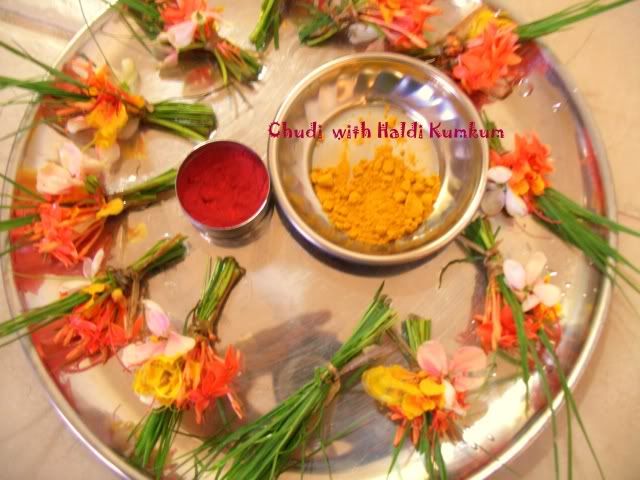
I got up early in the morning so that I cud finish everything by 8 ( including my breakfast). I prepared Rulavan godshe as Naivedya for Tulsi ( orels I wud have prepared God Povu but this sweet was on demand by Guru nd his friend). He he he myt be this was the first Friday where we got up so early…..
I wanted to post this on Saturday itself but then thought lemme wait till Sunday so tht I can post 2 festive special on tht day. That’s Chudi pooja And Nagar Panchami.
Now spare with me and try to read the significance of both the festivals. I have collected it from Many sources like my Mom, Granny nd last but not the least Google God(:O)……..google god bcoz I think ne one has a bit of doubt they always ask google….he he he.
Now for the significane:
Tulsi:
Tulsi came out of the ocean during Amrita manthan as a younger sister of Lakshmi. She too was devoted to Lord Vishnu and wanted to marry him. But Lakshmi who was already married to him did not like the idea and cursed her to become a plant. Thus the tulsi plant was born. But the all merciful Lord Vishnu took pity and fulfilling her wish declared that when he will be in the form of a saligram she will remain close to him in the form of a tulsi leaf. Therefore even today a saligram will have a tulsi leaf along with it. In front of every GSB home there will be a tulsi katta in which a plant grows round the year.
Although the prayers are offered to the Lord in Tulsi everyday by watering the plant in the morning and lighting an oil lamp before it in the evening, on Kartik Shukla Dwadashi there will be an annual Tulsi Pooja in the evening (in some quarters morning also) when the tulsi katte will be beautifully decorated and there will be clay tray lamps glowing besides firework by the children with the support of the elders in the home. It will be a joyous occasion. In the northern India in some communities it is called the Tulsi vivah or the wedding day of Tulsi with the Lord.
Choodi Puja:
A tulsi plant has medicinal properties capable of purifying the surroundings. In the month of shravan our ladies will adore tulsi on every Friday and Sunday with ‘chudis’ of flowers.

The door step (Humboru/Hosthilu) are decorated with chalk designs (Rangoli or Humbraa Chalk). This is how i decorated.
First, pooja is offered to Tulsi plant with a lamp, water drops are fed to the Tulsi plant and also consumed by the one offering the pooja (Aachamana). Haldil and Kumkum are applied to Tulsi as a symbol of womanhood, sweet is offered( any sweet which is prepared at home) (but ne thing made of rice is not offered), followed by Soorya Namaskaara(Sun Worship).
Then Choodi is offered to Tulsi and aarati (Flame)( I got a new plate for Aarti) is shown to Tulsi.

I got tulsi and planted it here and performed the Pooja.
There are no mantras and no shlokas but the married ladies alone can perform this pooja after a fast in the morning. Among the married ladies, those who are close in relation(elders) but far away by location are remembered and a mini-chudi will be sent by mail/post with a little kumkum (vch I m going to do). And they will send a similar chudi with her blessings. Thus in the month of Shravan our chudis will cross the seven seas and travel to far off lands
Later, they offer pooja and Choodis to the Door step (Humboru). Finally, all the gods within home are offered similar pooja and Choodis.
The remaining Choodis are offered to elderly women by the younger ones. They all wear the Choodi in their hair locks. In return, the elders also present a choodi to the younger ones. For the next four weeks or eight days, GSB women will be busy, going from house to house, offering choodis and receiving choodis!. But I wudn be bz going here nd there :O.
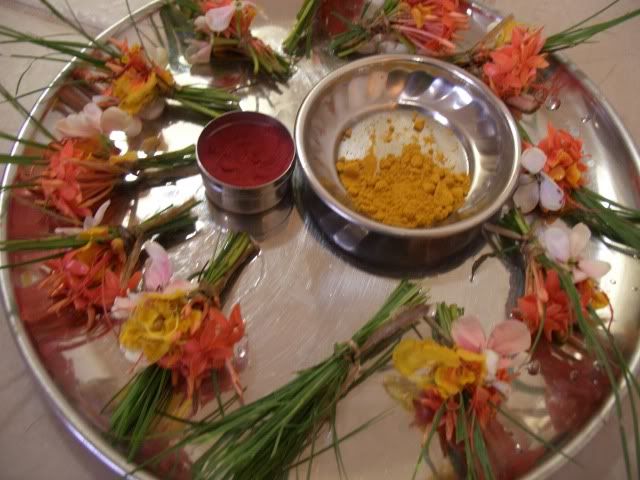
There is also a custom, that the wife offers the first Choodi to her husband along with a worshipped coconut Veedo (beetle leaves with Arecanut), believed to bring happiness and goodwill for married women and husnabds long life.
Superstition apart, Choodi Pooja is symbolic where a woman feels complete within her married life. This pooja also gives scope for women to keep social contact with their families at least once a year!

A standard Choodi requires many flowers and herbs to be collected, as mentioned here -
1. Ratnagandhi
2. Ratha Pushpa
3. Gauri Pushpa
4. Kaaylya Dolo (Crow's Eye)
5. Anwaali
6. Aarati Pushpa
7. Kangani Pushpa
8. Shanka Pushpa
9. Mithaai Pushpa
10. Cat’s Nails
11. Wild Grass (Dibrankoru)
12. Plantain yarn (Vaayu) for tying
13 Patkali
14. Small button roses( optional as it is being used these days).
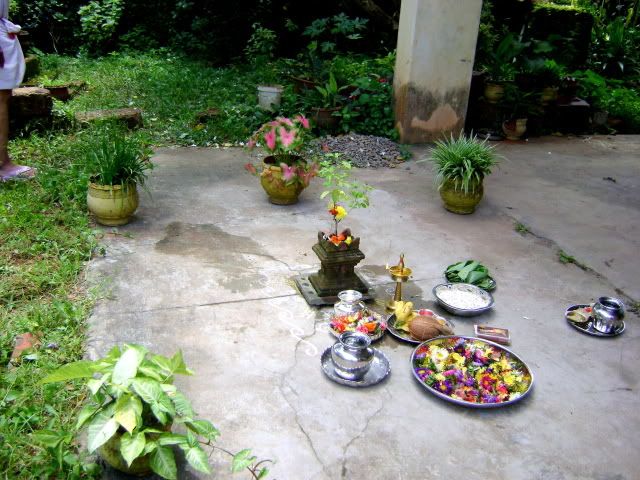
This was during my first chudi in magalore after marraige.
I cudn translate some name in english.... if some one knpows do let me know. And about adding all these flowers I m sure we cannot add all the flowers as these days its very difficult to find. I just added ratnagandi,dibrankoru,patkali(orange and pink).
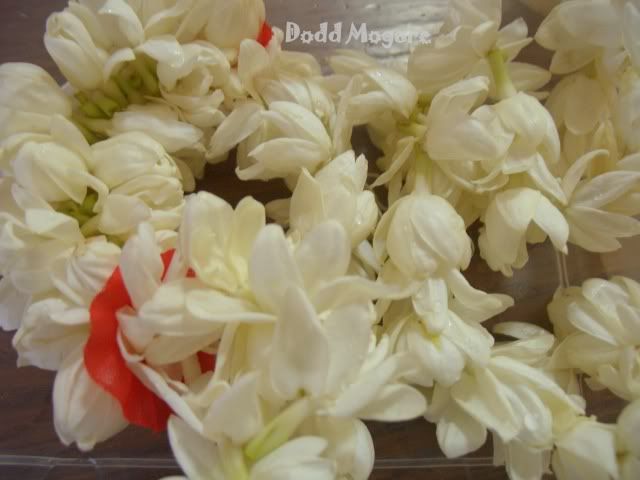
We even got Dodd Mogare for god.

This is Chikkoli which Anu had got for God at our house.
Nagar Panchami :
It is on the fifth day of the bright half of the Shravan that Naga Panchami, or the festival of snakes, is celebrated in India. Snake worship, no doubt, owes its origin to man's natural fear of these reptiles. However, in Hindu culture, they own a prominent place. Hindu mythologies are filled with stories and fables about snakes, the most important being the Sheshnaga of Lord Vishnu (it is on this snake that Lord Vishnu reclines while sleeping in the sea). Thus, it is quite understandable that a festival called Naga Panchami is observed in India, in the honor of snakes, every year.Naga Panchami is one of the most ancient fasts in India and also finds mention in the Puranas. It is believed to be one of the most auspicious days of the entire year. According to the Bhavishya Purana, when men bathe the snakes Vasuki, Takshaka, Kaliya, Manibhadra, Airavata, Dhritarashtra, Karkotaka and Dhananjaya with milk, on the fifth day of the bright fortnight of Shriven, they ensure freedom from danger for their families. As per a legend, on the day of Naga Panchami, ploughing a field is forbidden.There are a number of legends associated with Naga pancahmi. One has it that on this day, while tilling his land, a farmer accidentally killed some young serpents. The mother of these serpents took revenge by biting and killing the farmer and his family, except one daughter, who happened to be praying to the Nagas. This act of devotion resulted in the revival of the farmer and the rest of his family. Since then, Nag Panchami has been celebrated in India. It is believed that in reward for worship, snakes will never bite any member of the family. There is yet another legend related to the festival. It goes that young Lord Krishna was playing with the other cowboys near river Yamuna, when the ball got entangled in the high branch of a tree. Krishna volunteered to climb the tree and fetch the ball. Below the tree, a terrible snake Kaliya used to live in the river. Suddenly Krishna fell from the tree into the water. The terrible snake came up with anger, but Krishna started jumping on its head. Finally, Kaliya said sorry to Lord Krishna and He forgave the snake and let it go free. Since then, on Nag Panchami day, the victory of Krishna over the Kaliya snake is commemorated. In India, snakes are so revered that temples have also been erected in their honor. There is a particularly famous one in Mysore, at a place called Subramania (Sheshnaga). The Naga culture was fairly widespread in India before the Aryan invasion, and continues to be an important segment of worship in certain areas. After the invasion, the Indo-Aryans incorporated the worship of snakes into Hinduism. The thousand-headed Ananta is Vishnu's couch and also holds up the earth, while snakes play an ornamental role in the case of Shiva. Naga panchami is another form of honoring the snakes.
I Remember Anu (dad) used to perform the pooja in our family temple. Amma used to start early in the morning yelling at both the kids…. My bro nd Me. Utta Utta velu jatta magiri niddaychi all these things ( get up get up we r getting late u have a nap later). Nd we lazy bugs used to get up nd then get ready slowly. By the time everything is ready…….nd we perform the pooja and come bac home have have our breakfast (which wud be kotto(Just like idli but baked in jackfruit leaves) /idli most of the time.. Nd for Lunch she prepared patrado, rice, daali toy and cheppi keeri (rice in coconut milk). She never prepared Patholi more bcoz Anu never ate it we( bro nd me) ate one or 2. but Amma liked it…………so mamama( Amma’s Amma) used to get some at home.
Here my hubby loves it so he just asked me if I cud prepare it for him….nd I never said no……….. I never knew the recipe too so I called Amma to ask for the recipe but probably she was sleeping… then I remembered about Aayis Recipeand thought of following the same…nd when I was going thru tht I found my SIL on line and asked her the recipe once more she suggested the same….she even said tht instead of rice I cud use wheat flour…. But I never had a pinch of it at home….Evening I spoke to amma nd she too suggested the same.
I think u guys r tired of reading my scrap ain’t it? Plz spare me until I give u guys the recipe….ok ok il continue………………… Patholi is the most important sweet dish for Gowri festival and even Nagar Panchami. During these festivals, we can find ‘Turmeric leaves’ at native (those who are in , can find these leaves in Mangalore stores). leaves are used for this dish. Since I could not find any of these leaves here, I used Banana Leaves for preparing this. Though you would feel the absence of turmeric leaf fragrance( u can find the Banana leaf frangrance atleast), this is a very good idea for those who crave for patholi.
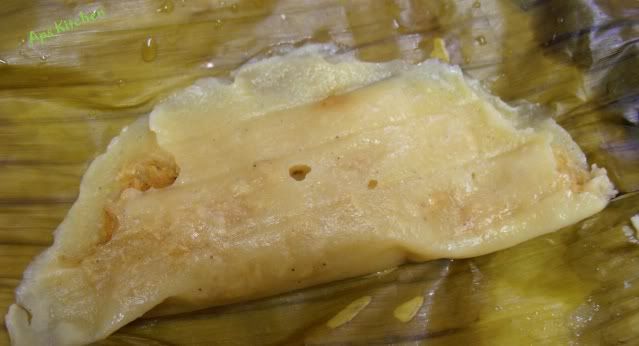
Ingredients:Coconut 1 cupRice 1 cupPoha(avalakki) 1/4 cup (one handful)
Jagegry – 3 tbsp(Amma suggested it)SaltTurmeric leaves 8-10 or Banana leaves cut into 5”* 5” squaresFor filling:Coconut 3/4 cupJaggery 1/2 cupCardamom powder 1/2 tea spn
Method:Soak the rice in water for around 1hr.Grind it along with coconut (without adding much water). Now add washed poha and grind to get a smooth paste. Add salt.
Heat coconut and jaggery mixing continuously till the jaggery melts and forms a uniform mixture. Add the cardamom powder.
Spread a thin layer of the rice paste on the leaf
Spread around 1-2 tea spns of stuffing on it.
Fold the leaf(or parchment paper) as shown.
Pile in the steamer or in a cooker vessel.
Steam it for around 12-15mins.
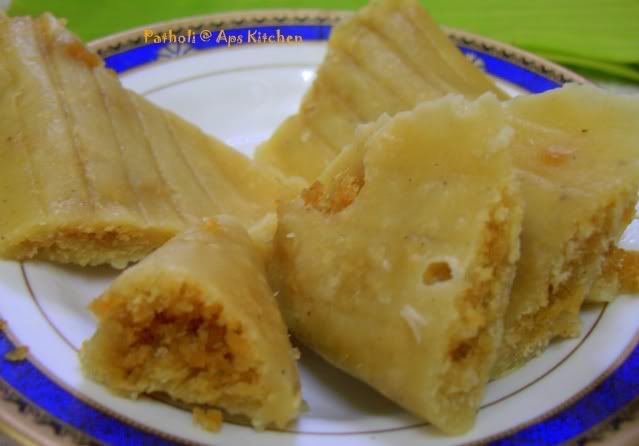
Preparation time : 40min
Makes around 8-10 patholis.
Tastes delicious with Ghee.

I m Sending this to Laxmi’s RCI Event hosted by Sia Of Monsoon Spice RCI-Udupi and Mangalore . Kodial/ Kudla/MangaloreRocks!!!!

Tastes Yum Yum
 when u add lozza love
when u add lozza love in it.
in it.Signing of after a big Post

 Home
Home










0 comments:
Post a Comment